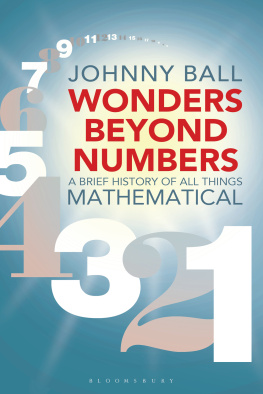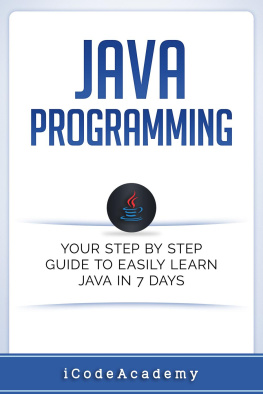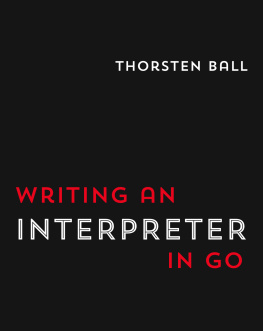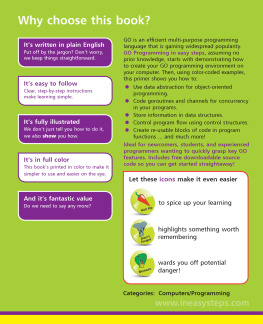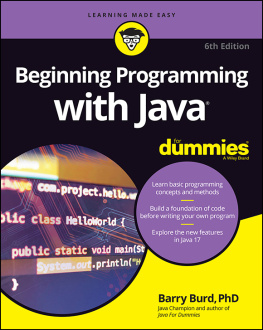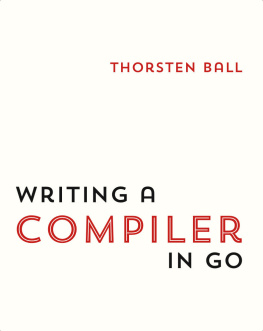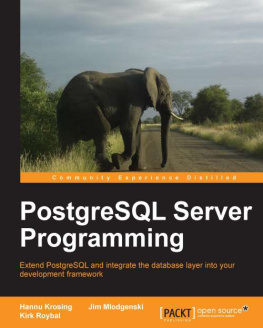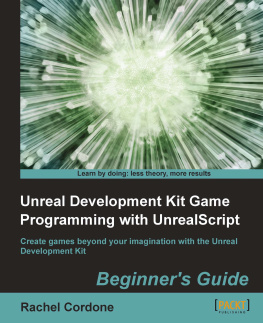Ball - Writing An Interpreter In Go
Here you can read online Ball - Writing An Interpreter In Go full text of the book (entire story) in english for free. Download pdf and epub, get meaning, cover and reviews about this ebook. year: 2016, genre: Home and family. Description of the work, (preface) as well as reviews are available. Best literature library LitArk.com created for fans of good reading and offers a wide selection of genres:
Romance novel
Science fiction
Adventure
Detective
Science
History
Home and family
Prose
Art
Politics
Computer
Non-fiction
Religion
Business
Children
Humor
Choose a favorite category and find really read worthwhile books. Enjoy immersion in the world of imagination, feel the emotions of the characters or learn something new for yourself, make an fascinating discovery.

- Book:Writing An Interpreter In Go
- Author:
- Genre:
- Year:2016
- Rating:3 / 5
- Favourites:Add to favourites
- Your mark:
- 60
- 1
- 2
- 3
- 4
- 5
Writing An Interpreter In Go: summary, description and annotation
We offer to read an annotation, description, summary or preface (depends on what the author of the book "Writing An Interpreter In Go" wrote himself). If you haven't found the necessary information about the book — write in the comments, we will try to find it.
Ball: author's other books
Who wrote Writing An Interpreter In Go? Find out the surname, the name of the author of the book and a list of all author's works by series.
Writing An Interpreter In Go — read online for free the complete book (whole text) full work
Below is the text of the book, divided by pages. System saving the place of the last page read, allows you to conveniently read the book "Writing An Interpreter In Go" online for free, without having to search again every time where you left off. Put a bookmark, and you can go to the page where you finished reading at any time.
Font size:
Interval:
Bookmark:
Thorsten Ball
I want to use these lines to express my gratitude to my wife for supporting me. She's the reason you're reading this. This book wouldn't exist without her encouragement, faith in me, assistance and her willingness to listen to my mechanical keyboard clacking away at 6am.
Thanks to my friends Christian, Felix and Robin for reviewing early versions of this book and providing me with invaluable feedback, advice and cheers. You improved this book more than you can imagine.
The first sentence of this introduction was supposed to be this one: "Interpreters are magical". But one of the earliest reviewers, who wishes to remain anonymous, said that "sounds super stupid". Well, Christian, I don't think so! I still think that interpreters are magical! Let me tell you why.
On the surface they look deceptively simple: text goes in and something comes out. They are programs that take other programs as their input and produce something. Simple, right? But the more you think about it, the more fascinating it becomes. Seemingly random characters - letters, numbers and special characters - are fed into the interpreter and suddenly become meaningful . The interpreter gives them meaning! It makes sense out of nonsense. And the computer, a machine that's built on understanding ones and zeroes, now understands and acts upon this weird language we feed into it - thanks to an interpreter that translates this language while reading it.
I kept asking myself: how does this work? And the first time this question began forming in my mind, I already knew that I'll only be satisfied with an answer if I get to it by writing my own interpreter. So I set out to do so.
A lot of books, articles, blog posts and tutorials on interpreters exist. Most of the time, though, they fall into one of two categories. Either they are huge, incredibly heavy on theory and more targeted towards people who already have a vast understanding of the topic, or they are really short, provide just a small introduction to the topic, use external tools as black boxes and only concern themselves with "toy interpreters".
One of the main sources of frustration was this latter category of resources, because the interpreters they explain only interpret languages with a really simple syntax. I didn't want to take a shortcut! I truly wanted to understand how interpreters work and that included understanding how lexers and parsers work. Especially with a C-like language and its curly braces and semicolons, where I didn't even know how to start parsing them. The academic textbooks had the answers I was looking for, of course. But rather inaccessible to me, behind their lengthy, theoretical explanations and mathematical notation.
What I wanted was something between the 900 page book on compilers and the blog post that explains how to write a Lisp interpreter in 50 lines of Ruby code.
So I wrote this book, for you and me. This is the book I wish I had. This is a book for people who love to look under the hood. For people that love to learn by understanding how something really works.
In this book we're going to write our own interpreter for our own programming language - from scratch. We won't be using any 3rd party tools and libraries. The result won't be production-ready, it won't have the performance of a fully-fledged interpreter and, of course, the language it's built to interpret will be missing features. But we're going to learn a lot.
It's difficult to make generic statements about interpreters since the variety is so high and none are alike. What can be said is that the one fundamental attribute they all share is that they take source code and evaluate it without producing some visible, intermediate result that can later be executed. That's in contrast to compilers, which take source code and produce output in another language that the underlying system can understand.
Some interpreters are really small, tiny, and do not even bother with a parsing step. They just interpret the input right away. Look at one of the many Brainfuck interpreters out there to see what I mean.
On the other end of the spectrum are much more elaborate types of interpreters. Highly optimized and using advanced parsing and evaluation techniques. Some of them don't just evaluate their input, but compile it into an internal representation called bytecode and then evaluate this. Even more advanced are JIT interpreters that compile the input just-in-time into native machine code that gets then executed.
But then, in between those two categories, there are interpreters that parse the source code, build an abstract syntax tree (AST) out of it and then evaluate this tree. This type of interpreter is sometimes called "tree-walking" interpreter, because it "walks" the AST and interprets it.
What we will be building in this book is such a tree-walking interpreter.
We're going to build our own lexer, our own parser, our own tree representation and our own evaluator. We'll see what "tokens" are, what an abstract syntax tree is, how to build such a tree, how to evaluate it and how to extend our language with new data structures and built-in functions.
Every interpreter is built to interpret a specific programming language. That's how you "implement" a programming language. Without a compiler or an interpreter a programming language is nothing more than an idea or a specification.
We're going to parse and evaluate our own language called Monkey. It's a language specifically designed for this book. Its only implementation is the one we're going to build in this book - our interpreter.
Expressed as a list of features, Monkey has the following:
- C-like syntax
- variable bindings
- integers and booleans
- arithmetic expressions
- built-in functions
- first-class and higher-order functions
- closures
- a string data structure
- an array data structure
- a hash data structure
We're going to take a detailed look at and implement each of these features in the rest of this book. But for now, let's see what Monkey looks like.
Here is how we bind values to names in Monkey:
let age = ; let name = "Monkey" ; let result = * ( / ) ;Besides integers, booleans and strings, the Monkey interpreter we're going to build will also support arrays and hashes. Here's what binding an array of integers to a name looks like:
let myArray = [ , , , , ] ;And here is a hash, where values are associated with keys:
let thorsten = { "name" : "Thorsten" , "age" : };Accessing the elements in arrays and hashes is done with index expressions:
myArray[] // => 1 thorsten[ "name" ] // => "Thorsten"The let statements can also be used to bind functions to names. Here's a small function that adds two numbers:
let add = fn (a , b) { return a + b ; };But Monkey not only supports return statements. Implicit return values are also possible, which means we can leave out the return if we want to:
let add = fn (a , b) { a + b ; };And calling a function is as easy as you'd expect:
add ( , ) ;A more complex function, such as a fibonacci function that returns the Nth Fibonacci number, might look like this:
let fibonacci = fn (x) { if (x == ) { } else { if (x == ) { } else { fibonacci (x - ) + fibonacci (x - ) ; } } };Note the recursive calls to
Font size:
Interval:
Bookmark:
Similar books «Writing An Interpreter In Go»
Look at similar books to Writing An Interpreter In Go. We have selected literature similar in name and meaning in the hope of providing readers with more options to find new, interesting, not yet read works.
Discussion, reviews of the book Writing An Interpreter In Go and just readers' own opinions. Leave your comments, write what you think about the work, its meaning or the main characters. Specify what exactly you liked and what you didn't like, and why you think so.


